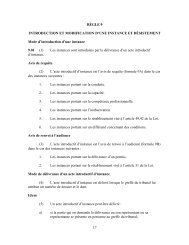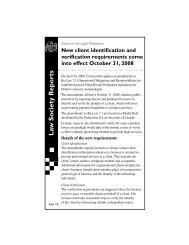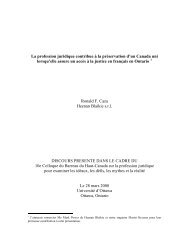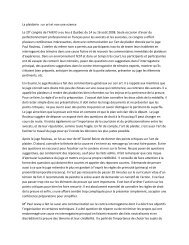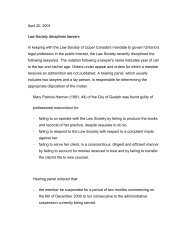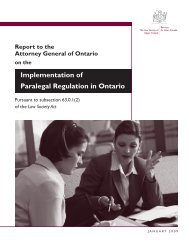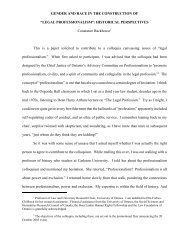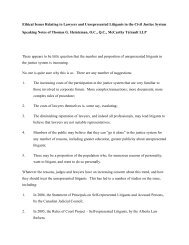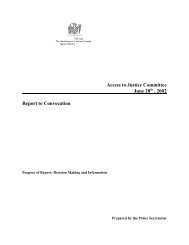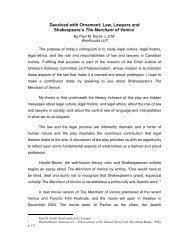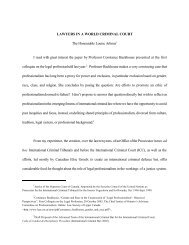of self regulation? - The Law Society of Upper Canada
of self regulation? - The Law Society of Upper Canada
of self regulation? - The Law Society of Upper Canada
You also want an ePaper? Increase the reach of your titles
YUMPU automatically turns print PDFs into web optimized ePapers that Google loves.
A look at the <strong>regulation</strong> <strong>of</strong> the legal pr<strong>of</strong>ession throughout common law countries<br />
confirms that pure <strong>self</strong>-<strong>regulation</strong> has increasingly become an endangered species. It<br />
appears, in fact, that <strong>Canada</strong> may soon be the only country in the Commonwealth where<br />
the pr<strong>of</strong>ession remains <strong>self</strong>-governing. <strong>The</strong> type <strong>of</strong> regulatory intervention and the degree<br />
<strong>of</strong> authority lost by the pr<strong>of</strong>essional bodies varies among jurisdictions. Some common<br />
threads are apparent, however. In most cases an independent regulatory agency has been<br />
created, one which is appointed not by the law society (or its equivalent) but by the<br />
government. Frequently the state reclaims responsibility for complaints handling and<br />
discipline and assigns it to this body, 79 but leaves the law society to establish codes <strong>of</strong><br />
conduct and standards <strong>of</strong> practice, and even to govern admissions and qualification.<br />
Finally, the new mechanisms that are introduced <strong>of</strong>ten provide for significant lay<br />
participation in the disciplinary process.<br />
<strong>The</strong> various jurisdictions <strong>of</strong> Australia and the United Kingdom are leading the<br />
charge against <strong>self</strong>-<strong>regulation</strong>, with other jurisdictions following close on their heels. In<br />
Australia, reforms to the <strong>regulation</strong> <strong>of</strong> the pr<strong>of</strong>ession have been unfolding for more than a<br />
decade. Because the legal pr<strong>of</strong>ession is regulated at the state, rather than the federal level,<br />
the regulatory structures are not traditionally uniform. Part <strong>of</strong> the reforms involves an<br />
effort to unify the regulatory systems across the country, and to improve the mobility <strong>of</strong><br />
lawyers. 80 <strong>The</strong> reforms are otherwise broadly similar: in most states the reforms provide<br />
for an independent, government-appointed body to handle the complaints and discipline<br />
79 In many cases, different types <strong>of</strong> complaints are handled differently, with the independent body taking<br />
responsibility for conduct complaints for example, while the law society retains (though <strong>of</strong>ten under<br />
supervision) jurisdiction over quality <strong>of</strong> service complaints, and the courts jurisdiction over civil claims<br />
against lawyers.<br />
80 See <strong>Law</strong> Council <strong>of</strong> Australia, “National Legal Pr<strong>of</strong>ession Model Bill” online:<br />
.<br />
24



